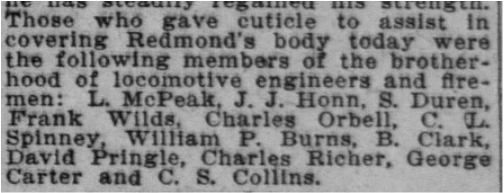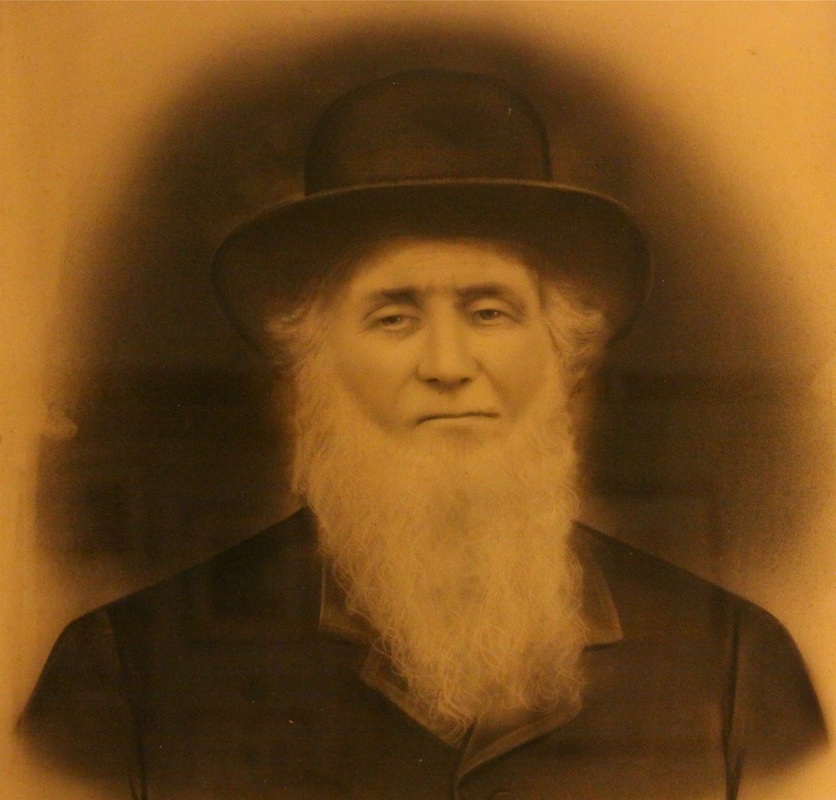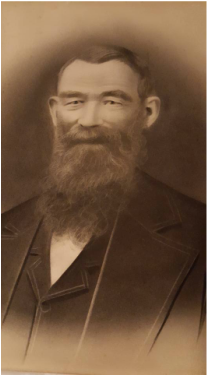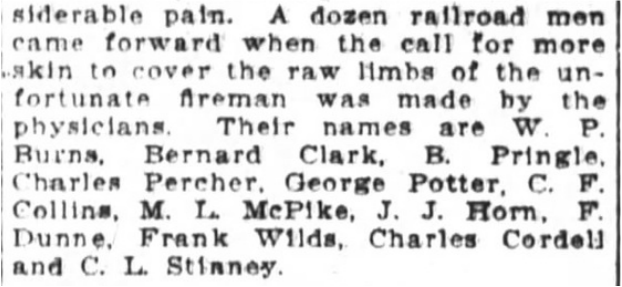|
Recently I had the opportunity to take a tour of the Pacific Northwest Railroad Archives in Burien (http://pnrarchive.org/) as part of the Historic Seattle “Digging Deeper” series of tours in various archives around Seattle. (http://historicseattle.org/blog). I have a number of railroading ancestors and collateral relatives and the tour made me want to write about one tragic tale of some of my Bradley trainmen. Today is the 87th anniversary of the events below.
My great grandfather, Patrick Bradley worked for the Northwestern Pacific Railroad, as did many of his relatives, including two nephews, George Francis and Paul Frederick Bradley, brothers who were employed by the NWP, George as an engineer and Paul as a conductor. On February 28, 1929, George Bradley was at the throttle of Engine 141, pulling a northbound passenger train. He received orders at Hopland directing him to pull onto the siding at Largo to let a southbound freight train pass. He likely even read those orders - when they were later found in his pocket, there was a smudge from a grease-stained leather glove on the corner as if he had unfolded the paper to read it.[1] But for some reason he ignored them. George ran the train right by the siding, and 400 yards north of the switch, collided headlong into Engine 184 pulling a train of cars full of timber. George had his head and shoulders out the window while he was rounding a curve in the road, and had no time to escape from the locomotive. He was killed instantly. His fireman, Don Mohn, jumped before the crash and escaped nearly uninjured.[2] Roy Landree, the fireman on the freight was killed instantly as well, as the timber from the cars immediately behind the locomotive shot forward like bullets from a machine gun.[3] The engineer of the freight, George Cunard, was injured and died a few days later in a San Francisco hospital.[4] Suffering minor cuts and bruises, Paul Bradley, conductor of the freight, helped remove the mangled remains of his brother, George, from the wreckage.[5] Much of the window frame had to be cut to extricate the body. (A picture of the wreck can be seen at http://tinyurl.com/jf6y77u) The Ukiah newspapers indicate that George was from Willits[6] and the Sausalito newspapers indicate he lived in Tiburon,[7] some 130 miles apart. I remember my father who was about six years old at the time of George’s passing, recounting his vivid memories of the funeral. It seems that George had a family at each end of his rail route. There was the first wife, Maye, at the north end and a second wife, Juanita, at the south end of the line. Dad recollected that Juanita was in the front pew of the church while George was laid out in front of the altar. Maye made her way to the front of the church, saw her husband in the coffin, shrieked, and collapsed to the floor. Dad said that eventually they went on with the funeral, but I don’t remember if both widows remained for the services. Another cousin, a daughter of George with Juanita who was almost 7 years old when her father died, remembered the sound of Maye’s clicking heels as she made her way way to the front of the church, and she recalled that Maye sat down in the front pew next to Juanita and proclaimed “I’m the real widow here.” I haven’t looked for a divorce record between George and Maye. There are a number of counties where they might have been divorced, and about a ten-year span between the birth of Maye’s second child and Juanita’s first. But it may be that there wasn’t ever a legal divorce. George, Maye and Juanita are long-gone and most of their stories buried with them. [1] Ukiah Republican Press, March 6, 1929, page 5 [2] Dispatch Democrat, March 2, 1929, page 1 [3] Ukiah Republican Press, March 6, 1929, page 1 [4] Ukiah Republican Press, March 6, 1929, page 5 [5] Dispatch Democrat, March 2, 1929, page 1 [6] ibid [7] Sausalito News, March 1, 1929, page 1
0 Comments
 San Francisco Call 18 August 1908, page 4 San Francisco Call 18 August 1908, page 4 Remember the Lay’s Potato Chips slogan, “Betcha Can’t Eat Just One”? You should think the same way about newspapers. If you find an article from one newspaper, check other newspapers in the same town, adjacent towns and perhaps the local large city to see if one of them might also have covered the story. You may find additional details, or an alternate spelling of a name. Here are two newspaper articles about the same event, a skin graft operation for Phil Redmond, a fireman with the Northwestern Pacific Railroad, who was badly scalded in a 1908 train wreck near Novato, California. Phil received skin grafts from over 200 men, and here is some detail on the brave men who stepped up to donate skin for one batch of donations. You can see from the date and a comparison of these two clippings that they refer to the same event, but they have different spellings of almost every name. The Chronicle article refers to Burns by his first name and initial, William P., while the Call just names him W. P. Burns. Having the Chronicle article gives the researcher a much better clue as to who the donor is. Another man is named Spinney according to the Call and Stinney in the Chronicle article. Without having the two articles to compare, one would have no clue that the names in one article are not the correct names of the parties involved. But seeing multiple articles from multiple sources provides much information to help the researcher.
When you're doing newspaper research, don't "eat" just one!  Normally on Sundays I try to post a story I have written. But yesterday was the anniversary of the death of my great-great grandfather, John Fields, so I'm going to post the transcriptions of the obituaries I have for him, and then a few comments at the end... From an unknown newspaper - this article was pasted into a scrapbook that came down through my family. I don't know if it was kept by my grandmother or one of her sisters. But because the clipping was glued in the scrapbook with no reference to the paper or date, I can only surmise it was from an Amador County Newspaper written in late February 1901. The Late John Field: John Field, after a lingering illness, died in Amador City on the 20th ultimo. He was a native of Ireland, being born in the county of Maith, 26 miles from the city of Dublin, October 11, 1801. When but thirteen years of age he started out to make his own living, and being an industrious, honest and faithful employee, he worked for one gentleman for a period of sixteen years. In 1840 he left Ireland and came to Boston and six years after he came to San Francisco.[1] In 1857 he came to Amador City where he remained up to the time of his death. Mr. Field was one of God's noble men, being loved and honored by all who knew him, and he will long be remembered by his many friends in Amador City, who sadly mourn his loss. He lived a pure and holy life and died a happy death. The interment took place from the Catholic church in Sutter Creek on the 22d of February, of which he was a member. He was buried by the side of his wife, to whom he was united in marriage many years ago in Boston, who preceded him to the grave eleven years ago. Scarcely a day passed during his last illness that he did not mention her name. Let us hope that they are united in Heaven, where sorrow never enters and where parting is unknown. May his soul rest in peace. A Second obituary I have for him, again, pasted into the scrapbook AMADOR CITY - Wm Fields who was probably the oldest citizen of Amador County passed from life unto death last Tuesday morning at the advanced age of 99 years and 10 months. Mr. Fields was born in Ireland, but became identified with Amador County when many of its gray haired men and women were children and to many of them he was more like a father than a neighbor and friend. He was a man of many striking qualities of mind and heart, generous kind and honorable. He was a member of the Catholic Church of Sutter Creek and within a short time of his death walked to and from the church with the vigor of youth. As we go to press Father Maloney before a large congregation of devoted friends and relatives is paying an eloquent tribute to the man whose upright life endeared him to so many. Deceased leaves a daughter Mrs. Mary Jane Hardy and three grandchildren to mourn his loss.[2] Here are two more pieces, both from the Amador Ledger: Amador City Mr. Fields, one of Amador's oldest citizens, is on the sick list. [Later: -- Mr. Field died Wednesday afternoon, Feb. 20, at the age of 99 years and 4 months.] and Nearly a Centenarian There died of la grippe at Amador City last Wednesday afternoon one of the oldest men in Amador county. His name was Field. For many years past he has made his home with his daughter, Mrs. J. Hardy, in Amador, though ninety-nine years of age he had been seldom afflicted with sickness. Mr. Field leaves a daughter, Mrs. Jeremiah Hardy, and several other relatives in Amador City. He was born October 19, 1801.[3] I have been smitten with John Fields since my childhood, probably because of the picture of him that hung in my Great Aunt Ida’s home. He has a long white beard and such kind and soulful eyes. I now have the picture hanging in my dining room and at Christmas-time, I tape a Santa hat upon his head. My Grandma Brown, John’s granddaughter, told me a few stories when I was a girl. She said that her mother, Mary Jane, and her parents, John and Mary Devlin Fields, sailed from Boston to San Francisco. It was a long journey with quite rough seas around the Horn. They brought a rocking chair with them. I recently tracked down an 1850s era bible that I believed belonged to John and Mary Fields, and I’m pretty sure he could hear all the way up in heaven my disappointment as I discovered he had not written one word in it – the lovely pages between the Old Testament and New Testament where he could have (SHOULD HAVE!!!!) written the family genealogy were completely blank. John, if you’re reading this from heaven, throw a record or two my way, will ye. Pleeeeease! [1] Clipping indicates "six years after (1846) he came to San Francisco" I believe this is an error. His daughter, Mary's, death certificate indicates she was born in Boston, Massachusetts, January 1, 1854, and the 1860 census of Amador County shows John, 60, Mary, 40, both born in Ireland, and Mary Jane, 6, born in Massachusetts. I would presume the word "six" should be interpreted as "sixteen". [2] Note that there is some inconsistency in these two obituaries. If he was born in October 1801 as the first obituary states, he could not have been 99 years and 10 months (notation in second obit) in February of 1901 (from first obit). Also, every document, census, etc that I have for him indicates his name is John Field/Fields, and I believe the name “Wm” mentioned in the obituary is in error. [3] Amador Ledger, 22 February 1901, page 3 I have used newspapers extensively to learn more about my ancestors and fill out my family history, but if I could offer just one tip for newspaper research, it would have to be to read the entire paper. Oh, how that one tip could have saved me years and years of research.
I traveled to California to go to a library which held microfilm of my ancestors’ local newspaper, the Petaluma Courier. I found the obituary I was looking for, that of my great-great uncle, John Ahern. It was short and to the point: “AHERN – Near Oakland, June 18, 1896, John C., youngest son of J. Ahern of Petaluma and brother of James Ahern, a native of Sonoma county, aged 22 years.”[1] The obituary mentioned only his father and one brother, making no mention of another brother, Henry, and three sisters, Sarah, Belle, and my greatgrandmother, Mary Bradley . There was nothing to indicate how or exactly where he died. Of course I followed up with Alameda County to secure a death certificate for John, but came up empty. I’d theorized that maybe he was always sickly (his mother died in childbirth delivering him) or perhaps some sort of an accident. Fastforward a few years, again to another trip to California, this time to the Bancroft Library at the University of California in Berkeley, where I searched in the Oakland newspapers for an obituary for John. I didn’t find an obituary for John Ahern, but I found a surprise – an obituary for John Lockren. “LOCKREN - In this city, June 18, 1896, John C., beloved son of Ann Lockren and James Ahern, brother of Charles and Mary Lockren, Henry, James and Sarah Ahern, Mrs. Belle Green and Mary Bradley, a native of Sonoma, California, aged 22 years, 9 months and 17 days.”[2] This was my guy, but why was Ann Lockren listed as his mother? James Ahern only had one wife, Jane. And who were these additional siblings, Charles and Mary Lockren? I read additional issues of the Oakland and San Francisco papers trying to find more about the railroad accident which caused the death of John Ahern/Lockren. One brief article concerning the coroner’s inquest stated “It developed at the inquest that the correct name of the young man was John Ahren (sic), he having taken the name of his step-father.”[3] Over time, of course, I did my due diligence, getting the death certificate for his “mother,” Ann Lockren. No help there, but a clue came in the death certificate for Charles Augustus Lockren, which stated his parents were Michael Lockren and Anna Graham, both natives of Ireland.[4] Graham was the maiden name of Jane Ahern, John’s mother. She must be his aunt! If only, if only, if only I had read further in that original newspaper, the Petaluma Courier of June 24, 1896, I would have seen on the very next page a three-paragraph article all about the death of John Ahern, containing the significant tidbit, “He lived with his aunt and other relatives at Oakland.”[5] Of course the aunt wasn’t mentioned by name in the Courier, so I guess it was a good thing I found the Oakland newspaper as well, but I could have saved myself a lot of head scratching and a lot of time if I had read just one more page of the original newspaper! [1] The Petaluma Courier, June 24, 1896, page 2 [2] Oakland Enquirer June 19, 1896, page 4 [3] Oakland Enquirer June 20, 1896, page 5 [4] Death Certificate for Charles Augustus Lockren, 11 January 1911, California State Board of Health, County of Alameda. Certified copy in possession of author [5] The Petaluma Courier, June 24, 1896, page 2 A little love story in honor of Valentine’s day…
When I was a child I particularly loved those stormy winter nights with a hard rain and thunder and lightning. I remember standing with my sister in front of the crackling fire in the Franklin stove in our family room, begging our parents to tell us again how they met, knowing that with the storm outside and their memory of another storm years before, they couldn’t help but indulge us. Dad would start… “I was sitting on a bar stool in Tiburon and somebody came in.[1] He said, ‘Tom, the Brotzes[2] are having a party next week. There’ll be lots of pretty girls there. Do you and John want to go?’ I said, ‘I can’t speak for John, but I’ll go.’”[3] So Dad went to the party. There he met an attractive brunette, Mrs. Hartman. Big brown eyes. A great smile. And could she fill out a dress!!!! (wink wink) They spent the evening talking. And then Mom would chime in… “A few days later, I was on the street car and So-and-so[4] who was at the party asked me if I was going to marry Tom and I said ‘Yes.’” But I’m not sure Dad was yet on the same page… “A couple of days after the party Whosit[5] wanted to know if I’d called Rosemary yet. I said, ‘No.’ ‘Well, why not?!!!!’ ‘Well, she’s divorced.’[6] Whosit laughed, ‘No, you idiot. She’s a widow!’” Well that was all the encouragement Tom Kircher needed. He called Rosemary up. Three weeks later they were engaged, and three weeks later they were married. And the rest is history. But… but… tell the part about the storm. Pleeeeease!!!!! Dad would continue…“So, early on we went on a date. Your mother was living with Grandma and Grandpa Brown. I picked her up and we went out. And then I brought her back home. And I was going to take the street car back to downtown, but it would go out to the ocean first, and then go downtown.[7] So I got on it, and it did go out to the ocean, but then with the storm and the lightning it just shut down. No power. So I had to walk back to her house in the rain… And ask to stay the night… In her parents’ house. That I’d just met.” Then Mom would finish the story, “So I made up the couch for him. And in the morning I made him breakfast. And I burned the eggs. But he married me anyway.” My mother’s been gone more than 30 years and my dad eight, but even today when it’s a stormy night and the rain’s falling and the thunder’s rumbling, the memory of my parents’ story fills my heart and warms me all up inside. Now, go tell your kids your own love story. [1] I’ll tell the story much as I remember it, as my parents told it to me. I hope you historians out there will indulge me. The quotations probably aren’t exact, but close enough for my heart to love it and my head to be OK with any discrepancies [2] Herman and Leila Brotz were friends of my mother, kind of an honorary uncle and aunt. I think they lived in Oakland at the time. Leila was from New Zealand and had the most charming accent. I have no idea who it was in Tiburon who knew the Brotzes and how they knew they were having a party. [3] This was so like Dad, with that Jesuit education of his. He’d answer just what was asked, no more, no less, and absolutely no way would he answer for his brother! [4] I’m sure Mom said a name, but since I’m something of a historian and I can’t lie and make up the name so, you’ll just have to use your imagination that it was one of her girlfriends [5] See footnote 4… (but one of Dad’s guy friends) [6] Yes, this nice Catholic boy met “Mrs. Hartman” and, though she was quite the looker, there was absolutely no way no how that he was getting involved with a divorcee! [7] My mom and her parents lived at 1254 45th Avenue in the Sunset neighborhood of San Francisco, about a half a block south of Golden Gate Park and about 5 blocks from the Great Highway which runs along Ocean Beach Sometimes finding someone on the census is easy, but often you need to strategize, be open, and hope for a little luck.
The census images we look at today are not the original working copy of the enumerator. After a day in the field, knocking on doors and collecting information, the enumerator sat down and copied the data onto the final forms to be turned in. Perhaps it had been a long day, and the enumerator was a bit tired when he copied the names and details for the household of Douglas and Margaret Church onto page 31 for Sonoma Township, Sonoma, California of the 1870 census. He certainly appears to have been off a bit when he entered the information for lines 15 and 16 for James Church and Mary Laughlin.[1] Could it really be true that Douglas Church was born in Pennsylvania and his wife Margaret and their four-year-old daughter, Anna, were both born in California, but their son, one-year-old James Church, was born in England, and had a father and mother of foreign birth? Oh, and how about the tick mark in column 15 - that he attended school within the year? Little James must have been some Einstein! Either that or our census taker made a little booboo when he made his final copy. That error, mixing up a few tick marks and a birthplace, is what made it particularly troublesome for me to find Mary Lockren, already a difficult surname to search for. Poor penmanship aside, common spelling variants include Lockren, Lockran, Lochren, Lochran, Loughren, Loughran, Laughran as well as Locklin and Laughlin. Basically it starts with an L, has a hard C in the middle and ends in an N. After that it’s anybody’s guess. I knew from later census records that she was born about 1856 in England. As you can see from the census, using England as a birthplace, was most decidedly unhelpful in this case, so I did a simple search using just a name - “Mary L*N” - and an approximate age – 14. No birthplace. As a genealogist, it seems hard not to put in the information that I “know” is right. But sometimes less is more. And without that birthplace, Mary popped right up. A few pages away I found her mother, Anna “Locklin”, living in the household of James and Maria Kennedy.[2] Digging a bit further, I discovered Margaret Douglas was the daughter of Maria Kennedy.[3] Connection! And the Kennedys and Churches lived just over the hill from Anna Lockren’s sister, my great-great grandmother, Jane (Mary J) Ahern, in whose household lived one more “enumerator mistake” - Anna’s son, Charles “Lucking.”[4] Yep, sometimes the census taker was wrong, and it takes a little more than “luck” to connect the dots – try a less is more strategy. [1] Ancestry.com. 1870 United States Federal Census [database on-line]. Provo, UT, USA: Ancestry.com Operations, Inc., 2009. Images reproduced by FamilySearch. Year: 1870; Census Place: Sonoma, Sonoma, California; Roll: M593_91; Page: 446A; Image: 459; Family History Library Film: 545590 [2] Ancestry.com. 1870 United States Federal Census [database on-line]. Provo, UT, USA: Ancestry.com Operations, Inc., 2009. Images reproduced by FamilySearch Year: 1870; Census Place: Sonoma, Sonoma, California; Roll: M593_91; Page: 443A; Image: 453; Family History Library Film: 545590 [3] http://worldconnect.rootsweb.ancestry.com/cgi-bin/igm.cgi?op=GET&db=wjhonson&id=I273 [4] Ancestry.com. 1870 United States Federal Census [database on-line]. Provo, UT, USA: Ancestry.com Operations, Inc., 2009. Images reproduced by FamilySearch. 1870; Census Place: Vallejo, Sonoma, California; Roll: M593_91; Page: 456A; Image: 479; Family History Library Film: 545590  James Ahern circa 1870 (Original charcoal portrait from the collection of Danni Chambers Meisinger) James Ahern circa 1870 (Original charcoal portrait from the collection of Danni Chambers Meisinger) I recently presented my “Where There’s a Will There’s a Way…” lecture to the Belfair Chapter of the Puget Sound Genealogical Society. Here’s one of the stories I shared. In 1873, my great–great-grandfather, James Ahern, suddenly found himself a 42-year-old single father with a house full of children. His wife, Jane, died delivering baby number six.[1] James died 25 years later but never remarried. For a man in that day and age, a farmer with not only six youngsters to raise but a 160-acre farm and a barn full of dairy cattle to tend to, it’s quite unusual to not have found a helpmate to marry. But research into the will of his next-door neighbor shed a little light on how he might have managed to get his kids raised without taking another wife. The 1880 census begins to tell the tale. James appears with his six children, from Mary Agnes, age 20, down through Henry, James, Sarah, and Jane to John C, age 7.[2] I think Mary Agnes was probably pretty capable of taking on much of the responsibility for her younger siblings. She was 14 when her mother died, and she went on to raise a large family of her own. Right next door are Isaac and Mary Ingram.[3] Isaac and Mary had no children of their own. But on October 20, 1871, Isaac and Mary served as godparents to Jane Isabella Ahern,[4] so clearly the Ingrams had a close relationship with the Aherns. I can see among the farmhands living with the Ingrams in 1880 is one Patrick Bradley, a 32-year-old Pennsylvanian. About a year and a half after that census was taken, Mary Agnes Ahern married Patrick.[5] I can just see Mary Ingram finding excuses to fix these two up – “I baked a cake, Patrick, why don’t you take it over to the Aherns?” Just on a hunch, when I was visiting the courthouse in Santa Rosa, I looked up Mary Ingram’s will, and in it I found a few more details to confirm my theory that Mrs. Ingram likely played a pretty active role in the lives of the motherless children next door. She had three nieces and a nephew who were remembered in her will with specific bequests of $1000 each and additional named beneficiaries included “my friend Lizzie Bradley” (Patrick and Mary Bradley’s oldest daughter) who was bequeathed $200, “my friend Mary Bradley,” given $200, and “my friend Sarah Ahern” who was given $100. Once the specific bequests were made and the final expenses paid, Mary divided the residuary of her estate two-ninths to each of her nieces and nephews and one-ninth to Lizzie Bradley.[6] Lizzie was deaf, and perhaps this disability led Mary Ingram to be particularly generous toward her. Wondering about how it was that a widower with a whole passel of children could manage to survive without a wife… imagining what kind of an influence Mary Ingram might have had in bringing lovebirds Patrick and Mary together… these thoughts led me to look for the will of my ancestor’s neighbor. I don’t think many genealogists have the next-door-neighbor’s will on their list of “must get” documents, but I’m glad I thought to put it on mine! [1] Sonoma County California death records, 1873-1890, Volume 41, page 1, Jane Aheran, October 9, 1873 [2] US Federal Census Year: 1880; Census Place: Vallejo, Sonoma, California; Roll: 84; Family History Film: 1254084; Page: 23D; Enumeration District: 121; Image: 0049 [3] ibid [4] Baptismal records of St. Vincent de Paul Catholic Church, Petaluma, Sonoma, California [5] Marriage records of St. Vincent de Paul Catholic Church, Petaluma, Sonoma, California [6] Sonoma County, California Record of Wills, Volume J, page 252 Optical Character Recognition, OCR for short, has been a great boon to genealogists. Using OCR technology, organizations have scanned and digitized an array of printed material and made it available on the internet. It is definitely a timesaver to have the computer read a newspaper for you and locating all instances of the name you’re searching for. But just how good a reader is that computer?
OCR by its nature reads letters one by one. If just one letter in the word you’re searching for was poorly inked, either too lightly or too heavily… if there was even a tiny smudge of dirt on the sheet before it was scanned… if the newspaper was first microfilmed, and then scanned… all of these things can adversely impact the computer’s ability to correctly read the words. Spend a bit of time learning about OCR using newspaper and book sites that display the OCR interpretation alongside the actual page image. These include the California Digital Newspaper Collection (www.cdnc.ucr.edu) and the Hoosier State Chronicles (newspapers.library.in.gov). Even if you don’t have ancestors who are likely to be mentioned in these collections, you’ll begin to learn that a lowercase “y” is often misread as a “v” or the letter combination of “rn” is misread as “m” turning the word “Ahern” into “Ahem.” Then when you go back to searching in those collections that do hold the newspapers from your ancestor Henry Ahern’s hometown, make sure you search for Henrv Ahem as well. |
AuthorMary Kircher Roddy is a genealogist, writer and lecturer, always looking for the story. Her blog is a combination of the stories she has found and the tools she used to find them. Archives
April 2021
Categories
All
|


